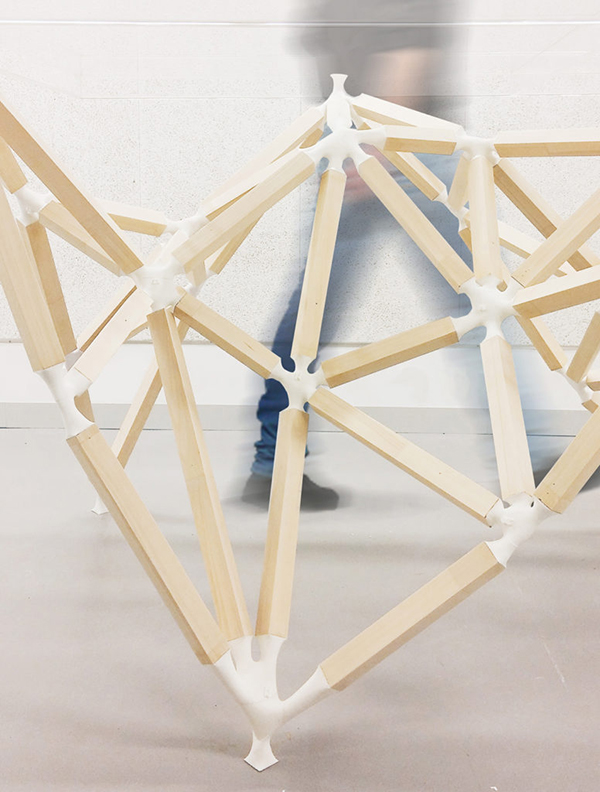
Honorable Mention
2016 VMODERN Furniture Design Competition
Emily Leung, Manuel Muehlbauer
Australia
DESIGN
The Sydney Opera Bar VIP Centrepiece is a scaled-down physical embodiment of the iconic Opera House in Sydney. This re-interpretation reflects the aesthetics of the shell structures as a sculptural form and references to waves, integrating the context of the site and the poetry of opera music in a vital relationship. It also expresses the long story of architecture, which requires the collaborative practice between the areas of design, engineering and manufacturing to successfully manifest architectural artefacts.
COMPUTATIONAL DESIGN + DIGITAL FABRICATION
The unique geometry forming the elegant shells of the sculptural Sydney Opera Bar VIP Centrepiece could only be achieved through the application of computational methods during the constrained period of time. Coupling rapid prototyping based on 3D printing and computational design methods based on parametric design and scripting into a holistic digital fabrication approach provides a highly relevant methodology for the computational design of complex geometries in the context of product and architectural design. Furthermore, the interconnected workflow between high-end modelling and digital fabrication processes reveal the potential of mass customization to drive the evolution from mass production to individualized fabrication methodologies for building components.
COLLABORATION
Parametric modelling combined with structural analysis and optimisation tools create new opportunities for communication and interaction while connecting the areas of design and engineering. Therefore, the initial model, as the basis for the design process of this project, was created in Rhinoceros and Grasshopper. The computational model was developed in a collaborative approach of the designers together with those collaborators, who focused on integrating the computational engineering methods into the design process. Developing the original script with the Grasshopper plugin Karamba as a parametric structural engineering tool established the capacity for analysis of structural properties as well as optimization of the overall structure and the structural nodes, which both must withstand the heavy use of the bar table.
PROCESS
Assembled from three elements (timber struts, acrylic table top and 3D printed nodes), many design iterations were leading the connected subsystems from the original design to the built product. The reality of designing and building complex objects is ensconced in the Sydney Opera Bar VIP Centrepiece as the embodiment of the non-linear design process that enforces deeper exploration during design iterations, allowing creative decision making to take place in a collaborative approach shared between all parties. Even though methods of advanced modelling and manufacturing have great potential in creating complex geometries, a more important aspect on this journey was the potential for quick, continuous adjustments, simulation and prototyping to incorporate the reactive capacity to deal with the contingency encountered in complex systems. Regardless, the experience of building the Sydney Opera Bar VIP Centrepiece led to a highly integrated design approach between engineers, architects and manufacturers, without which the final outcome would have never been achieved.
CONCLUSION
We believe that just like the remarkable story of the making of the Sydney Opera House, contemporary design processes based on collaboration and computational design methods provide an exciting experience during the realisation of highly complex design outcomes.

This story was originally published in vmodern.com.
Congratulations to all involved:
Project lead
Associate Professor and Director of Computational Design, M. Hank Haeusler (UNSW CoDe)
Design
Emily Leung (UNSW CoDe)
Narissa Bungbrakearti (UNSW CoDe)
Design support
Montanna Green (UNSW CoDe)
Sarah Xaviera (UNSW CoDe)
Simon Giang (UNSW CoDe)
Rebekah Araullo (UNSW CoDe)
Node optimisation
Manuel Muehlbauer (SIAL / RMIT)
Associate Professor Jane Burry (SIAL / RMIT)
Structural optimisation
Dr Sascha Bohnenberger (Bollinger Grohmann)
Fabrication coordination
Marjo Niemela (Design Futures / UNSW)
Construction team
Peter Kolasinski (Design Futures / UNSW)
Edward Iverach (Design Futures / UNSW)
Gabriel Norman (Design Futures / UNSW)
3d Print optimisation
Kin Ly (Design Futures / UNSW)
Interested in projects like this? Then check out our Computational Design degree here.
